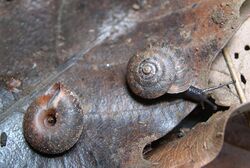Biology:Bradybaenidae
| Bradybaenidae | |
|---|---|

| |
| A live individual of Fruticicola fruticum | |
| Scientific classification | |
| Domain: | Eukaryota |
| Kingdom: | Animalia |
| Phylum: | Mollusca |
| Class: | Gastropoda |
| Subclass: | Heterobranchia |
| Order: | Stylommatophora |
| Superfamily: | Helicoidea |
| Family: | Bradybaenidae Pilsbry, 1934 (1898) |
| Genera | |
|
See text | |
Bradybaenidae is a taxonomic family of medium-sized to small land snails, terrestrial pulmonate gastropod mollusks in the superfamily Helicoidea.
These snails are found mainly in Asia, with only one species occurring in Northwestern Europe: Fruticicola fruticum.
The name of the family and the genus Bradybaena is derived from the Greek words bradus (= slow) and baino (= walk), meaning "slow walker".
Molecular phylogenetic studies from 2007 showed that bradybaenids are closely related with the Camaenidae, which are currently recognized as a distinct family. In these studies both Bradybaenidae and Camaenidae are mutually polyphyletic, together forming a monophyletic group, however. This finding suggests that the distinction of both families as based essentially on the absence (Camaenidae) or presence (Bradybaenidae) of a diverticulum, is arbitrary. This anatomical structure was apparently lost (or was gained) in several groups in convergence and is therefore not suitable for the delimitation of natural groups.[1]
Anatomy
Some genera of snails in this family create and use love darts as part of their mating behavior. The dart sac contains one to two glands. They are also defined by missing a diverticulum.
In this family, the number of haploid chromosomes lies between 26 and 30 (according to the values in this table).[2]
Taxonomy
The following two subfamilies were recognized in the taxonomy of Bouchet & Rocroi (2005):
- subfamily Bradybaeninae Pilsbry, 1924
- tribe Aegistini Kuroda & Habe, 1949
- tribe Bradybaenini Pilsbry, 1934 - synonyms: Eulotidae Möllendorff, 1898; Fruticicolinae Kobelt, 1904; Buliminopsinae Hoffmann, 1928
- tribe Euhadrini Habe, Okutani & Nishiwaki, 1994
- subfamily Helicostylinae Ihering, 1909 - synonyms: Pfeifferiinae Gray, 1855; Cochlostylidae Möllendorff, 1890
Genera

Genera within the family Bradybaenidae include:
subfamily Bradybaeninae - they are defined by the presence of two divided glands with one to two accessory sacs.
tribe Aegistini
- Aegista Albers, 1850 - for example Aegista mackensii
- Coelorus Pilsbry, 1900
- Lepidopisum Habe, 1957
- Mandarina Pilsbry, 1895[3]
- Trishoplita Jacobi, 1898
tribe Bradybaenini
- Ainohelix Kuroda & Taki, 1933
- Bradybaena Beck, 1837 - for example: Bradybaena similaris, the Asian trampsnail
- Cathaica Moellendorff, 1884
- Coccoglypta Pilsbry, 1895
- Eulota Hartmann, 1843
- Ezohelix Kuroda & Emura, 1938
- Fruticicola Held, 1838 - for example Fruticicola fruticum
- Laeocathaica Moellendorff, 1899
- Metodontia Möllendorff, 1886
- Nesiohelix Kuroda & Emura, 1943 - for example Nesiohelix swinhoei
- Phaeohelix Kuroda & Habe, 1949
- Plecteulota Moellendorff, 1892
- Ponsadenia Schileyko, 1978
- Pseudiberus Ancey, 1887
- Pseudobuliminus Gredler, 1886 - for example Pseudobuliminus incertus
tribe Euhadrini
- Euhadra Pilsbry, 1890
subfamily Helicostylinae - they are defined by the presence of one gland that is being inserted without accessory sac (Tricheulota group) or with accessory sac (Helicostyla group).
- Calocochlia Hartmann, 1840 (nomen nudum)
- Canistrum Mörch, 1852
- Cochlostyla Pilsbry, 1895
- Helicostyla Férussac, 1821
- Phoenicobius Mörch, 1852
- Tricheulota Pilsbry, 1895
The genus Monadenia Pilsbry, 1895 used to be placed in this family,[4] but it has been moved to the family Xanthonychidae.
References
- ↑ Wade C. M., Hudelot C., Davison A., Naggs F., Mordan P. B. (2007). "Molecular phylogeny of the helicoid land snails (Pulmonata: Stylommatophora: Helicoidea), with special emphasis on the Camaenidae". Journal of Molluscan Studies 73(4): 411-415. doi:10.1093/mollus/eym030.
- ↑ Barker G. M.: Gastropods on Land: Phylogeny, Diversity and Adaptive Morphology. in Barker G. M. (ed.): The biology of terrestrial molluscs. CABI Publishing, Oxon, UK, 2001, ISBN:0-85199-318-4. 1-146, cited pages: 139 and 142.
- ↑ Davison A. & Chiba S. (2006). "Labile ecotypes accompany rapid cladogenesis in an adaptive radiation of Mandarina (Bradybaenidae) land snails". Biological Journal of the Linnean Society 88(2): 269-282. doi:10.1111/j.1095-8312.2006.00624.x.
- ↑ [1] Integrated Taxonomic Information System (ITIS) Bradybaenidae Taxonomic Serial No.: 77713 cited 18 July 2007
External links
Wikidata ☰ Q1818076 entry

